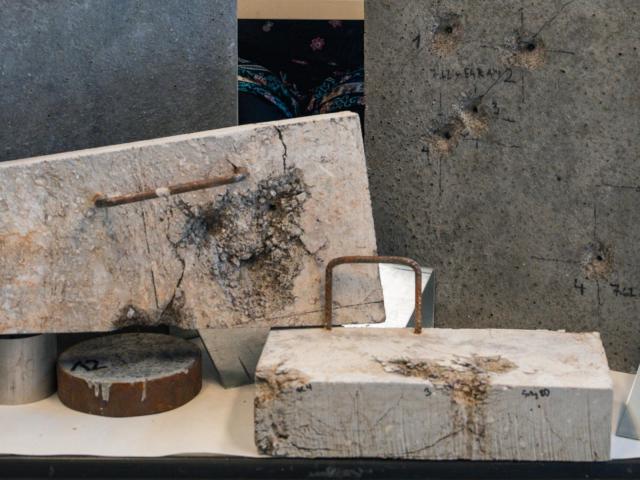selected results
Ballistic protective panel
The ballistic panel, made of advanced fiber-reinforced cement composite, offers A3-level protection against small-caliber projectiles (STANAG 2280). It is ideal for protecting critical infrastructure—such as energy, IT, and defense facilities—where heavy concrete barriers are impractical. Unlike expensive steel panels, this lightweight modular solution offers comparable protection at one-fifth the cost.
Developed by FCH BUT in cooperation with Athex Technology, the panel is already integrated into mobile systems of interest to the Czech Army. These will be presented at the IDET 2025 fair. The project continues to develop new applications for mobile and fixed security solutions. With its combination of effectiveness, mobility, and affordability, this panel presents a significant innovation with broad potential impact for increasing security across Europe.

Self-adhesive film with a photoactive layer exhibiting self-cleaning properties
This self-adhesive film, developed in response to post-COVID demands for safer surfaces, features a light-activated antimicrobial layer. It combines approved biocides with singlet oxygen generation to eliminate bacteria and viruses on touchscreens. Tested in real-life environments—such as fast food outlets, supermarkets, and airports—it is currently used by DM drugstores. The film is highly durable (withstands 30,000 touches), easy to clean, and simple to remove.
Developed by Fortes Interactive with FCH BUT, SYNPO, and Tomas Bata University, the product is protected by a Czech patent, with a U.S. application pending. The film is already in production and under evaluation for use in healthcare. Thanks to its wide applicability, durability, and ease of use, this technology has the potential to become a global standard in touchscreen protection.

Biotechnological processing and valorization of waste glycerol by carotenogenic yeasts
The result is a verified technology that utilizes Rhodotorula toruloides, a carotenogenic yeast, to convert waste glycerol from biodiesel production into valuable biomass. The process supports circular economy principles by transforming industrial by-products into high-value supplements, feed additives, or ingredients for cosmetics and pharmaceuticals. The yeast strain was selected for its ability to grow on waste substrates and produce carotenoids, lipids, proteins, and antioxidants.
Developed at FCH BUT in cooperation with Algae Farm, large-scale cultivation was successfully demonstrated in a 2000 L reactor at the Algatech Centre in Třeboň. Commercial products like LiveLin and AnimaLin are already on the market. A new biotechnology facility is under construction in Buku near Příbram to further scale production. This innovation has strong commercialization potential both within Europe and globally.

Production of polyhydroxylkanoates employing thermophilic bacterial isolate Aneurinibacillus sp. H1 (patent, 2020)
This patent protects Aneurinibacillus sp. H1, a thermophilic, gram-positive bacterium capable of producing biodegradable polyhydroxyalkanoates (PHAs). Isolated from compost and stored under CCM no. 8960, this strain thrives at 45–50 °C, reducing contamination risks and energy costs. Its gram-positive nature eliminates endotoxins, making it ideal for biomedical applications. A key advantage is the bacterium’s ability to incorporate different monomers (e.g., 4-hydroxybutyrate) into PHA copolymers, enhancing material flexibility for use in cosmetics, medicine, and more.
While licensing discussions with Nafigate were paused due to internal changes, BUT is actively seeking new commercial partners. This innovation represents a promising step toward sustainable plastic alternatives and biopolymer applications in high-value markets.

Technological line for the separation of photovoltaic panels (utility model, 2023)
With the growing number of decommissioned solar panels, efficient recycling is essential. This new recycling line separates glass, aluminum frames, and wafer materials from end-of-life PV panels. A key innovation is thermal decomposition, which removes polymer bonding layers more effectively than mechanical methods. Glass is then sorted by particle size for reuse. Additionally, wafer materials are compressed into alloying tablets containing up to 50% wafer content, reducing the need for virgin raw materials.
Developed in collaboration with VIA ALTA, the system achieves up to 95% recycling efficiency. It is expected to be implemented in practice between 2025–2026. This solution contributes to a circular economy in both photovoltaic and metallurgical industries and responds to increasing legal requirements for e-waste recycling.
